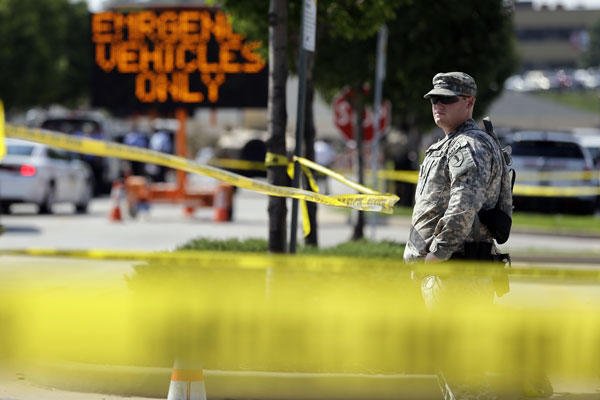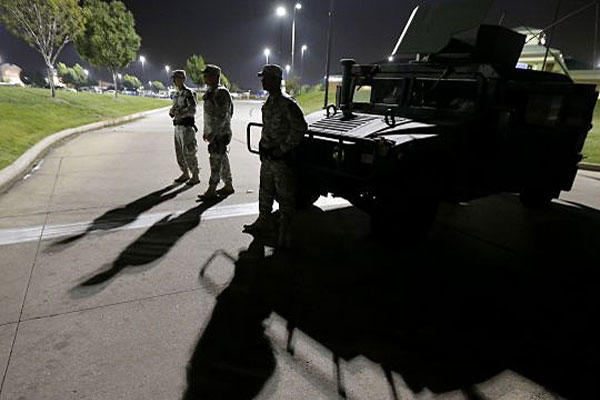The Missouri National Guard has selected military police officers and other soldiers with law-enforcement backgrounds to help provide security in Ferguson, an official said.
Gov. Jay Nixon this week ordered the state's National Guard to the St. Louis suburb, which has been rocked by protests and violence since the Aug. 9 killing of an unarmed black teen and robbery suspect, Michael Brown, by a white police officer, Darren Wilson.
The initial mobilization was for up to 200 military personnel, though only about 80 were on the ground as of Monday night, according to news reports. The role of the soldiers -- the vast majority of whom are police or corrections officers -- is limited to guarding the so-called Unified Command Center authorities set up to coordinate the response to the waves of protests.
"These guys were hand-selected because they're cops themselves or have a law enforcement background," an official told Military.com. "They're being picked from all over the state."
National Guard troops are regularly activated for domestic deployments, often to help provide humanitarian relief after hurricanes, floods and wildfires. The last time they were mobilized in response to a widespread civil disturbance was during the 1992 Los Angeles riots, though at the time thousands of troops were called up.
The soldiers in Ferguson are part of a statewide Guard contingent of roughly 11,000 personnel and fall under the command of Brig. Gen. Gregory Mason, a combat veteran who has served in Iraq and spent three decades in his civilian career at the Missouri State Highway Patrol. In his current role overseeing Guard operations in Ferguson, he reports to Col. Ron Replogle, the superintendent of the highway patrol, which took over security last week at Nixon's request.
Nixon declared a state of emergency in recent days as the security situation deteriorated and authorized the deployment of the National Guard.
In a statement on Monday, he said peaceful protests were marred by "violent criminal acts" committed by a growing number of people, many of whom came from outside the state. He cited such examples as firing upon law enforcement officers, shooting a civilian, throwing Molotov cocktails, looting and a coordinated attempt to block roads and overrun the Unified Command Center, he said.
"Given these deliberate, coordinated and intensifying violent attacks on lives and property in Ferguson, I am directing the highly capable men and women of the Missouri National Guard to assist Col. Ron Replogle and the Unified Command in restoring peace and order to this community," Nixon said.
The soldiers are guarding the command center "so that law enforcement can continue to protect the people and property of Ferguson," according to a statement on Tuesday from Staff Sgt. Joshua Mickels, a spokesman for the Missouri National Guard. The troops were to continue to do so throughout the night.
Mickels' boss, Capt. John Quin, wasn't able to be reached for comment. Officials in the Guard's public affairs office referred questions about the deployment of soldiers in Ferguson to Mike O'Connell, a spokesman for the Missouri Public Safety Department, who didn't respond to multiple requests for comment.
Even before the arrival of troops on the ground, the use of tactical weapons and trucks by police in Ferguson and St. Louis County as a means to control crowds sparked a debate about police militarization and cast a spotlight on the Defense Department's equipment transfer program initially designed to help law enforcement agencies fight drug criminals.
The Defense Logistics Agency's so-called Excess Property Program, or 1033 program, dates to the early 1990s and authorizes the Pentagon to transfer to local law enforcement agencies hand-me-down weapons and equipment, from clothing and sleeping bags to computers and digital cameras to guns and armored trucks.
Since its inception, the effort has transferred more than $5 billion worth of defense equipment and supplies to more than 8,000 local law enforcement agencies, according to the DLA's Disposition Services website.
The trend picked up dramatically after the terrorist attacks of Sept. 11, 2001. The value of transfers increased more than tenfold within the past decade, from 34,708 transfers worth $33 million in 2006 to 51,779 transfers worth $420 million last year, according to an article by Niraj Chokshi of The Washington Post.
Since 2007, law enforcement officials in Ferguson received two Humvees, one generator and one cargo trailer, while those in St. Louis County accepted seven Humvees, six pistols, a dozen rifles and night-vision equipment, according to Navy Rear Adm. John Kirby, the Pentagon press secretary.
"We don't take a position on the way the equipment is used," Kirby said during with a briefing with reporters on Tuesday. That's up to local law enforcement, he said.
Defense Secretary Chuck Hagel is aware of the debate over the supply of surplus military equipment to police around the country and has asked for more information on the program, Kirby said.
Sen. Carl Levin, a Democrat from Michigan and chairman of the House Armed Services Committee, has pledged to conduct a review the effort when the chamber reconvenes in September.
"We intended this equipment to keep police officers and their communities safe from heavily armed drug gangs and terrorist incidents," he said in a statement. "Before the defense authorization bill comes to the Senate floor, we will review this program to determine if equipment provided by the Defense Department is being used as intended."
-- Richard Sisk contributed to this report.
--Brendan McGarry can be reached at brendan.mcgarry@monster.com.




























